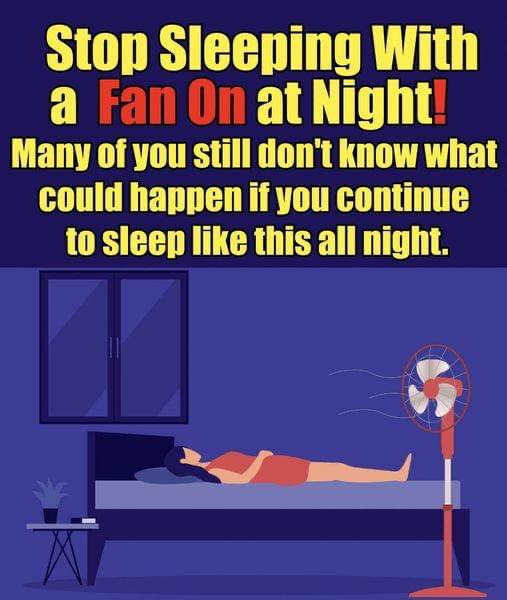For many, getting a good night’s sleep is the ultimate goal, while others just see it as a nightly necessity. However, the secret to waking up refreshed isn’t just about getting enough hours of sleep—it’s also about the quality of sleep. If you often find yourself tossing and turning or waking up feeling groggy, one simple factor could be to blame: using a fan at night.

The Importance of Quality Sleep
It’s no secret that quality sleep is essential for our well-being. Sleep not only allows our bodies to rest but also plays a critical role in mental and physical recovery. Experts recommend that adults get seven to nine hours of sleep each night. Lack of proper sleep can lead to a host of issues, including heart disease, diabetes, depression, and even a weakened immune system, making it easier to fall ill.
While many factors affect how well we sleep—such as stress, diet, and screen time—one key element is often overlooked: room temperature.
Why Room Temperature Matters
Room temperature is crucial for achieving deep, restful sleep. The ideal sleeping temperature usually ranges between 60 to 67°F (15 to 19°C). As you prepare to sleep, your body’s core temperature naturally drops, signaling that it’s time for rest. This natural cooling helps you transition into deeper sleep stages, including REM (rapid eye movement) sleep. Conversely, a room that’s too hot or too cold can interfere with your body’s natural temperature regulation, disrupting these important sleep phases.
How Fans Affect Sleep
While fans are a popular go-to for staying cool, they might not be as beneficial for sleep as you think. Fans don’t actually cool the room; they simply circulate the air. On particularly hot nights, this air circulation might not be enough to maintain a comfortable sleeping temperature, leading to restless sleep or waking up sweaty. On the flip side, if the room is already cool, having a fan blow directly on you can make you too cold, causing you to wake up shivering.
For those who rely on the gentle hum of a fan to fall asleep, the sound itself might be comforting, but the impact on temperature can be problematic. Even if the fan creates a relaxing atmosphere, the inconsistent air movement can cause fluctuating temperatures, disrupting your body’s natural sleep rhythms.
How to Optimize Your Sleep Environment
Achieving a good night’s sleep goes beyond just turning off the fan. Here are some effective ways to create an ideal sleep environment:
- Choose the Right Bedding: Opt for breathable materials like cotton or linen that promote airflow. These fabrics help prevent overheating. Avoid heavy, synthetic fabrics like polyester, which can trap heat and make temperature regulation difficult.
- Invest in a Cooling Mattress: Memory foam mattresses are known for retaining heat, which can interfere with sleep. Look for mattresses with cooling gel layers or materials that promote airflow. These upgrades can help maintain a comfortable sleep temperature throughout the night.
- Wear Lightweight Sleepwear: What you wear to bed matters. Choose breathable, moisture-wicking fabrics like cotton to maintain a comfortable temperature. Heavy pajamas may be cozy in colder conditions, but they can be too warm in a normal room setting.
- Consider White Noise Machines: If you’re accustomed to sleeping with the sound of a fan, a white noise machine can be a better alternative. These devices produce soothing sounds like ocean waves, rain, or wind, creating a calming sleep environment without altering room temperature. You can also use a voice-activated assistant to play sleep sounds on a timer.
- Use a Humidifier or Air Purifier: To combat dryness that can be caused by fan use, a humidifier can add moisture to the air, reducing the risk of waking up with a dry throat or skin. Air purifiers can also help by improving air quality and reducing allergens, making breathing easier and sleep more comfortable.
How Temperature Impacts Sleep Hormones
Temperature doesn’t just affect comfort; it also influences the production of melatonin, the hormone that regulates sleep-wake cycles. Cooler room temperatures support melatonin production, helping you fall asleep faster and stay asleep longer. In contrast, warmer temperatures can suppress melatonin, making it harder to drift off. This is why you’re more likely to experience restful sleep in a cool environment rather than a warm one.
The Road to Better Sleep
While using a fan might seem like an easy fix for cooling your room, it can sometimes do more harm than good by creating inconsistent temperatures. Prioritizing a stable and cool sleep environment is essential for improving sleep quality. By making simple adjustments to your bedroom—such as selecting breathable bedding, adjusting sleepwear, or adding white noise—you can optimize the environment for better sleep.
Sleep is one of the most vital processes our bodies undergo, providing both mental and physical rejuvenation. By understanding the role that temperature plays and making small changes, you can transform your sleep quality and wake up feeling more refreshed and energized.
Share Your Sleep Tips!
Have you found tricks that help you sleep better at night? We’d love to hear your thoughts! Share this story to spread the word about achieving better sleep, and let us know your best tips for a peaceful night’s rest.





